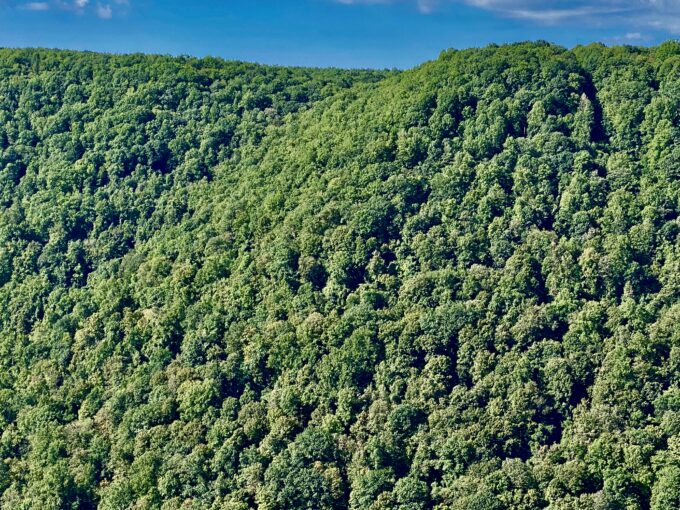
Mature deciduous forest, Mogan Ridge Roadless Area, Hoosier National Forest. Photo: Jeffrey St. Clair.
The verbiage in US Forest Service (“FS”) scoping letters (“SL”) and environmental assessments (“EA”) would have the public believe that all you have to do get your desired floristic composition (such as more oaks) is open up the canopy with chainsaws. This disinformation campaign, however, ignores the fact that there is far more influencing conditions on the ground and tree regeneration than simply the amount of canopy openness that exists. Numerous interacting factors at multiple spatial scales generate structural and compositional heterogeneity in forest habitats (Braun 1950, Runkle 1991a, Franklin et al. 2002, McEwan et al. 2010, Schlenker et al. 2024).
Shifting Mosaic
In terms of landscape ecology, a National Forest exists as a mosaic of patches (Urban, D.L. et al. 1987). The various patches composing a landscape mosaic are heterogeneous in space and time due to the interactions of three pattern‐forming templates (Swanson et al. 1988, Pickett & Rogers 1997, Angelstam 2003, McEwan et al. 2010):
‐ site‐specific physical conditions — including soil, slope aspect, hydrology, climate
‐ natural disturbance regimes
‐ biotic interactions — such as mutualism (including such mutualists as mycorrhizal networks (MNs)), competition, parasitism, predation (which includes browsing/grazing by Deer).
Broad- and fine-scale distributional patterns of understory and overstory forest vegetation result from synergies of these site-specific physical conditions, disturbance regimes, and biotic interactions (Watt 1947, Braun 1950, Swanson et al. 1988, DeMars and Runkle 1992, Callaway 1997, Pickett and Rogers 1997, Hutchinson et al. 1999, Angelstam 2003, Dyer 2006, Dyer 2010, Matlack and Schaub 2011, McEwan and Muller 2011, Chapman and McEwan 2012, Anning et al. 2014). In addition to moisture, edaphic, and topographic gradients (Ashe, W.W. 1922, Lawrence, D.M. et al. 1997, Stephenson and Mills 1999, McEwan, R.W. and R.N. Muller 2006; McEwan and Muller 2011), canopy gaps are a major factor structuring understory and overstory vegetation in deciduous forests of the eastern United States (Glasgow, L.S. and G.R. Matlack 2007a). All of these natural factors lead to multi-habitat landscapes with increased diversity and improved functionality (Hackett et al. 2024).
These templates must be considered and maintained to sustain the broad spectrum of diversity of habitat, communities, and ecosystems in our NFs. The physical environment includes such features as edaphic conditions (e.g., soil pH), elevation, slope inclination and aspect, temperature, and precipitation (Whitaker 1956). These factors influence fine-scale microclimatic patches and gradients that affect patterns of vegetation composition and structure (Jackson and Newman 1967, Chen et al. 1999, Stephenson and Mills 1999, Dyer 2009, Dobrowski 2010, Fleming 2012, Anning et al. 2014).
Disturbances (intermittent stochastic disruptions) occur in the canopy as well as in the understories, independently or in concert (Runkle, J.R. 1991b). The sheer age (seral stage) of forest tracts can influence the herbaceous community present there; generally, disturbance sensitive species are underrepresented in secondary forests (DeMars and Runkle 1992, Dyer 2010, Matlack and Schaub 2011). It may take decades and even centuries for plant species to colonize and populations to stabilize (see, e.g., Honnay, O. et al. 2005).
Thus, it is obvious that vegetation diversity and tree regeneration/recruitment results from far more than just the amount of canopy openness at a site.
The FS analyses and decisions neglect to fully and fairly consider this ecology (related to purpose & need rationale, existing conditions, and effects of the proposed actions) and their consideration/disclosure is inadequate and fraudulent.
Natural ESH
Due to natural processes early successional habitat (“ESH”) is constantly created in forests. Yet the agency repeatedly fails to fully and fairly consider/estimate/inventory/analyze all these amounts in their decision-making process. The only ESH they recognize is that fabricated by human logging and cutting. And the agency disregards the significant negative aspects associated with such fabrication (Kellet et al. 2023).
The FS does not properly consider the contribution of natural processes to maintaining habitat diversity, particularly “early successional habitat”, on the George Washington, Hoosier, and countless other National Forests (“NF”). The FS planners fail to properly consider and analyse natural ESH patches, particularly those under two acres in size (the scale of many canopy gaps). As a consequence, the NF managers constantly use a fallacious “need” to fabricate such habitat as a rationale for cutting down valuable and important mature and old-growth sites.
The truth is that our maturing and recovering NFs naturally contain a spectrum of developmental stages of forest growth due to regeneration at canopy gaps created by disease, snow & ice, lightning strikes and resultant fire, insect outbreaks (including Gypsy Moths), tree senescence, windthrow, Beavers, drought, flooding, and other small-scale natural disturbances (Braun, E. 1950, Rentch, J. 2006). The Forest Service does not and can not provide evidence that these factors do not operate in project areas on NFs.
A disturbance regime of small-scale, within-stand gap processes dominated the natural forests in the Eastern region (Rentch, J. 2006, Runkle, J. 1985, 1991a). Further, it is critical to consider that intensive logging operations not only significantly directly alter habitat conditions, but in addition they interfere with, impede, truncate, and/or prevent the expression of the natural disturbance regime. Something that one would not want to do if actual “restoration” was the goal.
The simple fact is, natural disturbances small and large are constantly happening somewhere throughout the National Forests, forming a shifting mosaic of habitats (see Shugart, H. and D. West 1981, and Harris, L. et al. 1996). With the sporadic nature of natural disturbances (see, e.g., JNF FEIS 3-107, 109), early successional habitat is naturally patchy or spotty and species are adapted to this.
The fact that the FS managers/planners might not formally inventory or monitor this natural early successional habitat or for some reason do not like its floristic composition does not alter the reality of its de facto existence on the ground. It must be fully and fairly estimated and assessed and properly considered.
A full and accurate appraisal of the “existing conditions” is the sine qua non of informed decision-making and honest public disclosure of impacts and rationale. Without this, logging decisions on NFs are unreasonable, an abuse of agency discretion, and illegal (in violation of the National Environmental Policy Act and Administrative Procedures Act).

Hardwood forests on Canaan Mountain, Monoghela NF. Photo: Jeffrey St. Clair.
Heterogeneous Species Composition
At any site, multiple successional pathways are possible post-disturbance (Egler 1954, Connel and Slatyer 1977). Various factors are responsible for this (e.g., site-specific physical conditions or the abundance of browsers), but it partially depends upon the starting point (see “initial floristic composition” in Egler 1954, Roberts 2004). For tree taxa in particular this means the existence of a seed bank and advanced regeneration (the seedlings already growing at a particular site) (Brokaw and Busing 2000). The cutting supposedly for oaks proposed for the HNF Buffalo Springs and GWNF North Shenandoah Mountain project areas and on a multitude of other NFs is NOT confined to sites with lots of advanced oak regeneration.
In eastern deciduous forests species composition is not spatially or temporally uniform (Dyer 2006, Dyer and Hutchinson 2019). In much of the East, Oak-Hickory dominance was naturally localized – typically on the drier sites (Paulus et al. 2018). In West Virginia Rentch and colleagues (2005) found the lowest herbal richness in Chestnut Oak forests; these tracts were associated with acidic soil conditions (Fleming 2012). In Kentucky, oak plots were in the driest most nutrient poor sites, while maple species were in the more mesic and nutrient rich sites (McEwan and Muller 2011). In the “Mesophytic” and “Beech – Maple – Basswood” regions, oak dominance across large broad areas is not to be expected everywhere and may exist in some places as a more-or-less unnatural condition facilitated/fabricated by major human disturbance — fires and large openings (using the FS’s own logic) and Chestnut blight and Ash borers and agricultural legacies and Deer killing (see, e.g., McEwan et al. 2010). After the Europeans invaded and took over, there were a lot more fires taking place over far more area. So, centuries of human-caused fires here can be expected to have resulted in an excess of oaks and other taxa called fire-tolerant. And this pyromania is what some in the FS are intent on “restoring” (follow the money).
In other words, oaks, just as other species, are naturally localized due to the synergies of the three landscape templates. See, e.g., Donaldson’s Woods and Pioneer Mothers, and Peters Mountain North and Frozen Knob, old-growth forests in Indiana and Virginia: these places are a mosaic of all-aged hardwood forests (natural templates in action). And in some locales, oaks are a dominant canopy species.
FS proposals such as the Buffalo Springs (Hoosier NF) and North Shenandoah Mountain (GWNF) projects are all about trying to force an artificial disturbance regime and manipulated composition upon thousands of acres and alter the overall forest type (e.g., mixed mesic) and forest structure (make it younger and even-aged).
Oak regeneration/recruitment is NOT simply a function of canopy openness. The FS would have the public believe that all it has to do is reduce the canopy tree cover with chainsaws across hundreds of acres and then oaks will crop up all across the landscape like magic. Not only is regeneration NOT due to simply opening the canopy with chainsaws, but that is certainly not all that is necessary for the FS to do — no, lots more tax dollar spending make work/job security must be inflicted ad nauseum, and that’s left out or obfuscated in the FS documentation and PR for the projects.
Indeed, and of great importance and that CANNOT BE EMPHASIZED ENOUGH:
Much of the agency’s intensive even-age logging does NOT typically result in oak-hickory stands. Subsequent additional “treatments” are always needed, such as “timber stand improvement” (mechanical and chemical), pre-commercial thinning, crop tree release, and commercial thinning. Finally, after the application of lots of tax dollars and other cultural/economic/energy inputs that alter stand structure and composition, oak-hickory dominant stands might result.
If the even-age logging imposed by the FS actually resulted in oak forests, they would NOT need to repeatedly go back to these sites over decades and manipulate the tree composition there – i.e., cutting/killing the “undesirable” (i.e., not of greater commercial value) species there.
And that is explicitly part of the management proposed for the Buffalo Springs, North Shenandoah Mountain, and many other areas (see the EAs and scoping letters).

Oak-Hickory forest, Panther Hollow, Hoosier NF. Photo: Jeffrey St. Clair.
MNs and Oaks
The landscape template of biotic interactions includes such mutualists as fungal mycorrhizal networks (MNs), which generally fall under two separate categories: Ectomycorrhizal (ECM) fungi and Arbuscular (AM) fungi. These two classes of MN have some fundamental differences and appear to compete with one another (Johnson et al. 2018 – research done at an old growth forest in southern Indiana). Species such as oak, hickory, and beech are served by ECM networks, whereas maples and tulip poplars are served by AM networks. ECM trees typically produce slow-decaying leaf litters with lower nutrient content relative to co-occurring AM trees, resulting in distinct biogeochemical nutrient economies. Because ECM fungi possess the ability to mine nutrients from detritus, whereas AM fungi do not, ECM trees may be most competitive in their own soils (Johnson et al. 2018). ECM networks are especially sensitive to intensive harvesting regimes.
Research has shown that ECM fungi decline overall, regardless of ecozone, due to harvesting (Wilhelm et al. 2017). In contrast, AM populations increased in harvested plots likely due to their common symbioses with successional plant cover (Wilhelm et al. 2017). By implication, the removal of mature ECM trees and the corresponding disruption of ECM networks may facilitate AM invasion and succession from oak-hickory to Maple-Tulip Tree ecosystems. In addition, soil compaction from harvesting profoundly affects ECM fungi abundance, structure, and function; it therefore raises concerns regarding forest productivity, juvenile tree regeneration/recruitment and long-term ecosystem functioning (Hartmann et al. 2014).
And yet, the FS consistently proposes/inflicts intensive cutting with extensive canopy removal and soil disturbance on hundreds of acres, supposedly to increase oaks. These impacts to and from MNs are significant issues that have not been fully considered in FS project analyses/decisions.
The fact that when some “maturing oaks and hickories age and die they are being replaced by trees such as maple and beech” (SL) does not mean that ALL of them are or that it is happening everywhere — the trajectories are heterogeneous in space and time due to the interactions of the three pattern‐forming templates. Because of this, at some sites oaks naturally may actually increase in number. And climate change modeling predicts that oaks will EXPAND their range northwards at places in the East. Further, oaks have the ability to remain in the understory for decades, biding their time, building up amounts of advanced regen and waiting for a natural disturbance release event.
“White oak usually becomes dominant in the stand because of its ability to persist for long periods of time in the understory, its ability to respond well after release, and its great longevity.” (Burns & Honkala 1990) Vol.2 at pg. 610) (emphasis added) “If regeneration of a white oak stand is the desired goal, then the implementation of a slower, more gradual approach to opening up the canopy may be necessary.” (Rebbeck et al. 2011 at pg. 2229)
A slower more gradual approach is natural processes operating over long periods (hundreds of years), i.e. proforestation (Moomaw et al. 2019.
Old Forests, Seral Stages, and Natural Disturbances
Habitat complexity generally increases as forests age (Franklin et al. 2002); amongst other benefits, this niche complexity provides refugia from predators (Finke and Denno 2006), a factor presumably of critical importance to small somewhat defenseless site-sensitive forest creatures who cannot run away or fly away from harm. A body of research indicates that canopy gaps, herbaceous vegetation, mushrooms, invertebrate richness or abundance, snags, and large woody debris amounts are generally more abundant in older forest habitats (Whitney and Foster 1988, Meier et al. 1995, Greenberg and Forrest 2003, Van de Poll 2004, Ziegler 2004, Webster and Jenkins 2005, Keeton et al. 2007, Scheff 2014). For instance, the stand-initiation and stem- exclusion stages of seral development (sensu Oliver and Larson 1996) (i.e., early successional habitat with high density of saplings) is commonly characterized by a depauperate herbaceous layer (Halpern and Spies 1995, Roberts 2004). A typical rationale used for timber sales is the assertion that after cutting the logged sites will have increased berry or soft mast production. However, this enhancement is only short-term (2-9 years), then the cutover sites have a very long period (30-60 years) of dense canopy with very low soft mast production (Reynolds-Hogland et al. 2006). The Forest Service consistently and unfairly disregards the harms and negative aspects of early successional habitat fabricated by logging older forest (Kellett et al. 2023).
The truth is that our maturing and recovering National Forests naturally contain a spectrum of developmental stages of forest growth due to regeneration at canopy gaps created by natural processes; though of course old-growth stages are much diminished at present, particularly in the East. A forest can be “intact” or “contiguous” yet have numerous canopy openings due to a variety of natural disturbances (see, e.g., McCarthy, J. 2001). In fact, this is the natural state of wild mature and old-growth forests in the East (Davis, M.B. 1996). Disturbances occur in the canopy as well as in the understories, independently or in concert (Runkle, J.R. 1991b). Such processes normally occur and can be expected to occur in the future, as nature is very capable of maintaining our National Forests’ ecological integrity without the assistance of commercial logging.
Though episodic, natural canopy gaps are a regular occurrence in Eastern NFs, their rates varying depending on the scale of natural disturbance events in a particular year and the forest type studied. On the GWNF, canopy gaps are said to annually form from natural disturbances at the rate/extent of “0.4 to 2.0% of the land area” (GW-JNFs Indiana Bat EA-20). This means that in any ten-year period (this is the increment used by the agency to define age classes and wildlife habitat), up to 4-20% of a project area may have natural esh conditions. These natural processes and conditions provide desirable and suitable habitat for Grouse, Deer, Turkey, Bear and a host of other species. The 1993 GWNF FEIS had estimated abundances of game populations under each alternative for comparison. The proforestation/natural processes option (Alternative 3) was clearly estimated to supply game populations far in excess of viable populations (in the case of Bears it was said to support the greatest numbers, for Turkeys the second greatest).
The congruence and harmonization, or lack thereof, of human disturbance (viz., cutting regimes) with the spatial and temporal parameters of natural disturbance and their associated biological legacies are of great concern (Franklin, J. et al. 2002, Keeton, W.S. 2004, and Flamm, B.R. 1990). Further, it is critical to consider that intensive logging operations not only significantly directly alter habitat conditions, but in addition they interfere with, impede, truncate, and/or prevent the expression of the natural disturbance regime. Mature forests are of the age that a mosaic of habitats is gaining expression due to the operant natural disturbance regime (Franklin, J. et al. 2002; Keeton, W.S. 2004). And still more such niche complexity (including canopy openings) can be expected to develop as mature forests develop into old growth (Dahir, S.E. and C.G. Lorimer 1996). Such heterogeneous forests (of sufficient age) typically include stands or patches dominated by young early successional forest, older early successional forest, mid-successional forest, young late successional forest, and old late successional forest (Frelich, L.E. and P.B. Reich 2003).
The Forest Service likes to claim that its logging operations mimic natural disturbance. This is flagrantly absurd. Natural disturbances do NOT remove huge amounts of biomass (in the form of large trees) from a community — nothing goes to waste. They remain on-site to form niche complexity and provide nutrients. Which is exactly the opposite of the current management regime impressed upon the ecosystems — the constant removal of the organisms that would otherwise be recycled into and enrich, sustain, and recompose the system. In a naturally wild old forest it is the persistence of ecological legacy throughout the course of natural disturbances that promotes such great diversity of community composition and forest structure (Hackett et al. 2024). Ecology is about legacies — that which happened, or didn’t, in the past forms the contemporary context of the present system. Some things are here that shouldn’t be and some things are missing that should be here. In this age of mass extinction and global climate change, the greatest value our National Forests can provide is to serve as ecological preserves.
Let Them Be
Our National Forests are composed of maturing biotic communities on their way to developing/recovering something like their original condition. The fact that there are immature stems of many species right now does not mean that the sites were always that way or will always stay that way. The FS refuses to deal with the temporal reality of these developing ecosystems that are in the process of developing their uneven-age natural structure with multi-layered canopies. Instead of forcing an artificial young even-age condition on these ecosystems, here on these public lands we should take the opportunity to maintain their ecological integrity and continue to let nature diversify and heal herself.










